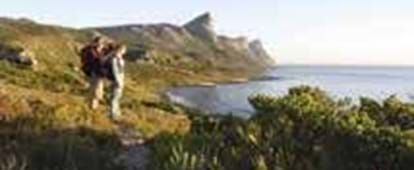By creating an account, I agree to the
Terms of service and Privacy policy
Choose your country and language:
Africa
Americas
Asia Pacific
Europe
TThe Table Mountain National Park Marine Protected Area (MPA) is arguably the most dramatic seascape in the country, curving around the long, thin Cape Peninsula.
Cartographically speaking, the Indian and Atlantic Oceans meet at the longitude of Cape Agulhas, the southernmost tip of Africa: 20.0131⁰E, and 220km or so to the south-east of the peninsula. But these two mighty oceans have no respect for cartographers, so it is off Cape Point, at the southern end of the Table Mountain National Park MPA, that their contrasting currents meet to create the weather that makes this region so distinctive and diverse.
As you stand at this very tip of the long, crooked Cape Peninsula, it feels as if you are inhaling air freshly blown at you from the icy Antarctic – because you are; and with it comes the freezing Benguela Current direct from the Southern Ocean: the reason the waters on the western side of the peninsula and the entire West Coast are so frigid.

SStreaming past Cape Agulhas from the north-east and meeting the Benguela Current in a twisted dance off Cape Point, is the warm Mozambique Current flowing from the Indian Ocean tropics: the reason Muizenberg and other False Bay beaches are marginally warmer than those on the other side of the peninsula.
The wind, waves and weather these currents create as they interact is extraordinary, and there is no denying the drama of the spectacle. Also, the diversity of life here, both in the water and onshore, is amazing. The marine park contains 43% of the all the species found along South Africa’s coast, making it something of an undersea biodiversity hotspot.
The Table Mountain National Park MPA stretches all the way around the Cape Peninsula, from Mouille Point near Cape Town’s CBD to Muizenberg in False Bay, taking in Green Point, Sea Point, Bantry Bay, Clifton, Camps Bay, Llandudno, Hout Bay, Chapman’s Peak, Noordhoek, Kommetjie, Cape Point, Simon’s Town, Fish Hoek, Kalk Bay and St James along the way. It includes rocky cliffs, sandy beaches, a lobster sanctuary, and several ‘no-take’ zones that act as nurseries for over-exploited fish species.
Wandering along the southern end of the Cape Peninsula is a highly intelligent tribe of baboons that spend a lot of time eating seafood – mussels, washed-up shark eggs and other edible pickings in the intertidal zone. Some primatologists have argued that their high-seafood diet makes these baboons brighter than others living off foods with fewer essential fatty acids: the fuel required to build bigger brains and boost intelligence.
Happily, this is not a reserve only to be looked at; the Table Mountain National Park MPA offers a high degree of interaction with this incredible seascape. You can surf, scuba dive and snorkel here (in a wetsuit – bear in mind the water is icy), or kayak, whale-watch and kite-surf. The park itself is well worth exploring, with its craggy mountains full of windswept floral beauty.
Just remember those clever seafood-eating baboons, and don’t leave your car unlocked as you step outside to admire the scenery – and never leave food out unattended.
TTravel tips & Planning info
Who to contact
Table Mountain National Park
Tel: +27 (0)21 712 0527
SANParks reservations
Tel: +27 (0)12 428 9111
How to get here
From the City Bowl in Cape Town, head towards Muizenberg (about half an hour’s drive) and carry on south towards Simon’s Town. You’ll soon enter the Cape of Good Hope section (the southern peninsula) of the Table Mountain National Park. The Table Mountain Park Marine Protected Area will be all around you.
Best time to visit
This area is dramatic any time of year, but the fynbos is in full spring flower between September and November, right after the winter rains – also usually a time of warm, sunny days.
Get around
There are tours to various destinations around the peninsula (check out the Cape Town Travel website), but if you hire a car, you’ll be free to see more at your own pace.
Around the area
You can see (and visit) South Africa’s tallest cast-iron lighthouse at Slangkop, near Kommetjie.
Tours to do
There are guided hiking tours on many of the trails in the Table Mountain National Park, and various marine excursions all around the peninsula. You might enjoy the hop-on, hop-off bus tours to places of interest in and around Cape Town, and a visit to the top of Table Mountain (by cable car, for those not up to the stiff hike) is also a must. Consult the listed websites for the options on offer.
Please bear in mind, however, that tourists in small groups can fall prey to muggers on more isolated mountain trails in the area, so hiking with accredited guides or in larger groups is recommended.
Length of stay
This is a delightful destination for a half or full day. Or stay for five days and hike the Hoerikwaggo Trail, which you can book through South African National Parks.
What to pack
Sturdy walking shoes or boots, hat, sunscreen, camera and binoculars. A wetsuit is essential if you plan to indulge in any water sports.
Where to stay
Cape Town itself, along with little peninsular towns like Kalk Bay, Muizenberg, Kommetjie, Scarborough and Simon’s Town, all have excellent accommodation options. But you may want to ask about the few rather splendid self-catering options within the Cape of Good Hope section of Table Mountain National Park.
What to eat
There is a restaurant at Cape Point. Simon’s Town has lovely seafood restaurants too.
Related links

|Terms and conditions|Disclaimer|Privacy policy|Social Media Terms and Conditions|Competition Terms and Conditions
